Sonos Ace
Sonos first premium headphone has lots of potential
Introduction
Sonos, a brand renowned for its high-quality consumer speakers and soundbars, has finally ventured into the headphone market with the Sonos Ace. Given Sonos reputation for quality audio in their consumer friendly products, there was a lot of anticipation surrounding the release of the Ace.

Note: I would like to thank Sonos for allowing me to borrow the Sonos Ace for a few weeks to gather the information for this review.
The Ace is currently available for $449 in both black and white options, I have been using the black version as you will see in the photos below.
In this review, I will delve into the details of the Sonos Ace, exploring its many features, sound quality, comfort, and see if it is the “best working from home” ANC headphone for you.
Unboxing and Build Quality
The Sonos Ace comes in a well-designed, sturdy box that reflects the brand’s premium image, my unit was already
loaned and therefore had been previously opened:
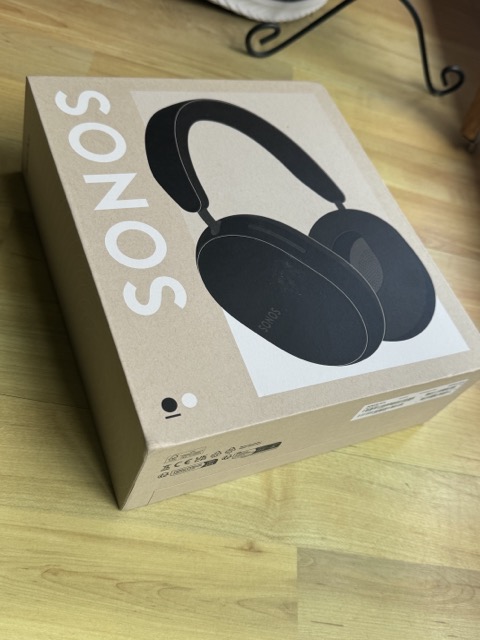
Inside the box you get an interesting case made from recycled materials:

Under the base you get a small box:
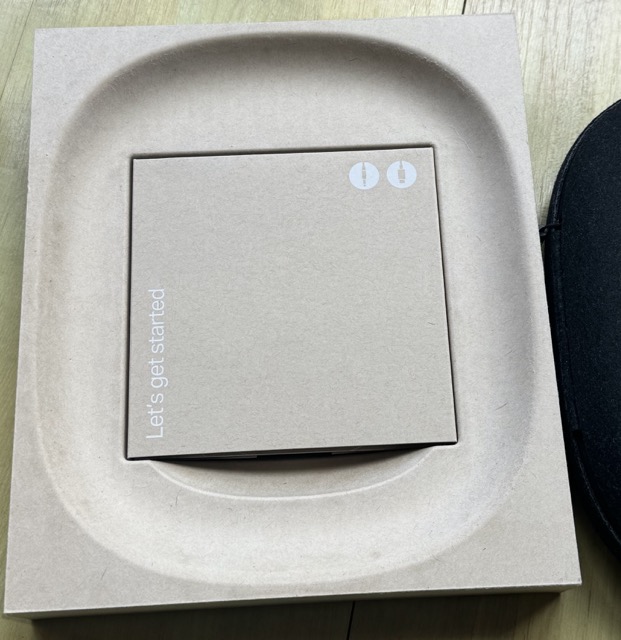
With the cables and a setup manual:
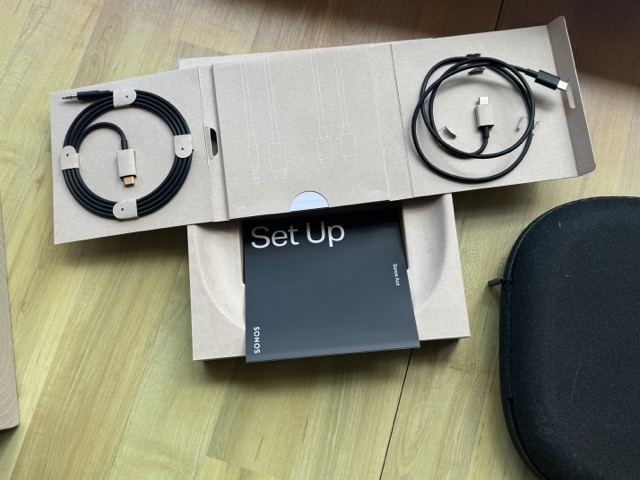 Note: My unit had already been opened and the cables had been used.
Note: My unit had already been opened and the cables had been used.
Inside the box, you’ll find:

The small magnetically attached cable case is a nice unique design choice.
Headphone build quality:
The build quality of the Ace is impressive, with a solid yet lightweight construction.

The materials used feel premium, and the design is minimalist and elegant, it is maybe slightly less premium than
the Airpods Max but Sonos have used material in an intelligent way to maximise the comfort so its is considerable
lighter than the Airpods Max.

The metal used in the extension mechanism high quality:

The Sonos logo on the right hand ear cup is understated:

The shape of the headphone is good and with the headband has a nice soft foam which compresses nicely:

The earpads are a nice shape, though in my ears they were slightly smaller than I would like:
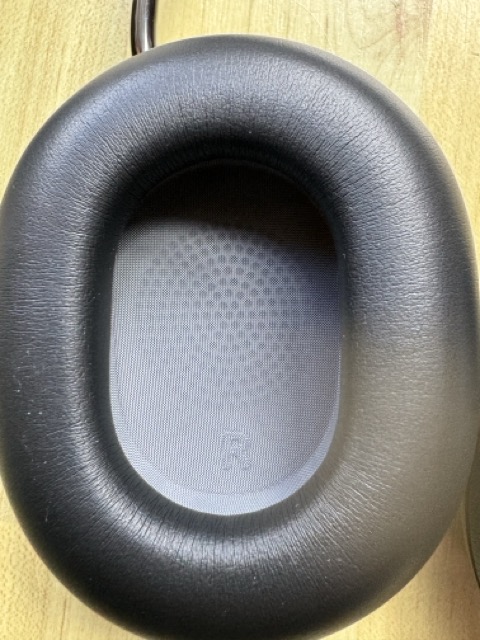
So, for example compared to the new Sennheiser HD490 Pro earpads which are the perfect size for my larger ears:

And compared with Hifiman Edition XS you can see how small the ear cups are:

But, the Ace are slightly bigger than the Airpods Max:
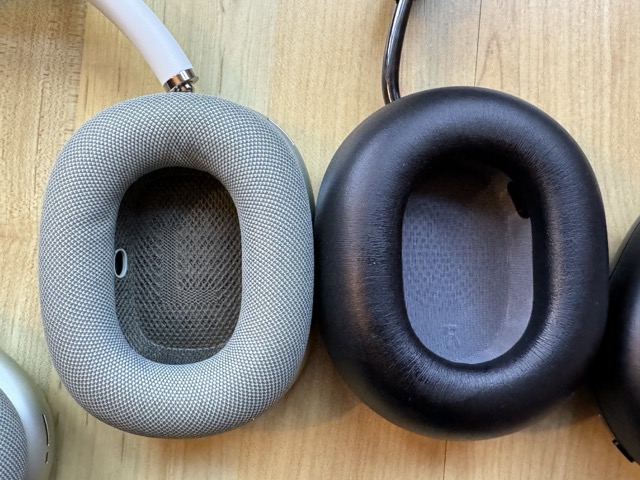
I thought it is interesting that Sonos have also adopted magnetic earpads.
I hope this becomes a standard in
headphones going forward as it is so convenient:
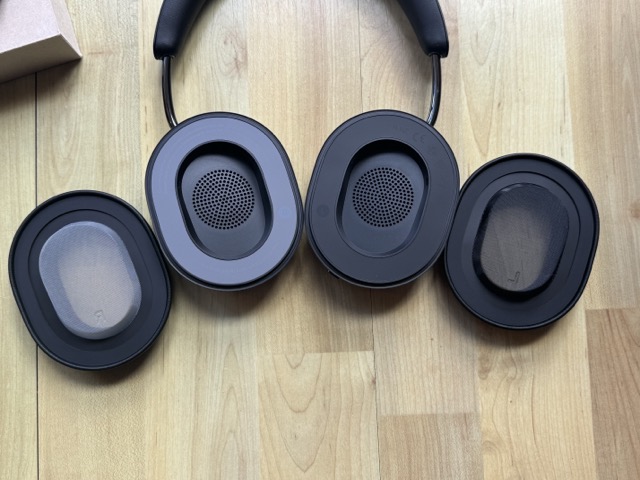 Note: I really like how cleverly Sonos used different colours on the left and right and it is super clever that they
each side as a different polarity, so you can’t mix them up by mistake.
Note: I really like how cleverly Sonos used different colours on the left and right and it is super clever that they
each side as a different polarity, so you can’t mix them up by mistake.
Here they are compared to the Airpods Max:

One thing to note is the way the Ace folds means they only fold up when you are wearing them rather than both
directions, so you can’t fold them down when wearing them:
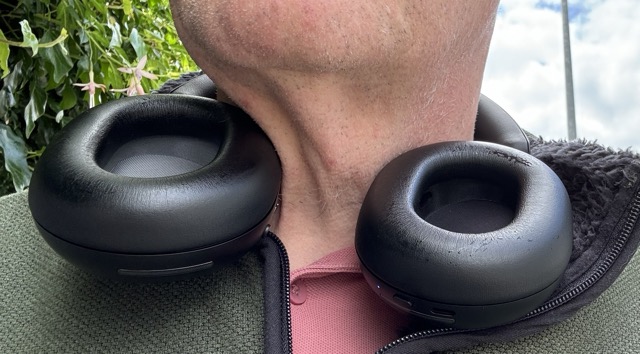
Comfort
Other than slightly too small for my ears I found the Sonos Ace is extremely comfortable to wear, thanks to its plush ear cushions and adjustable headband. But I did find them more comfortable than the Airpods Max (both in weight and inner ear comfort), But I did feel the earcups getting slightly warm when out on a long walk. I would hope given how easy it to replace the earpads that we will see custom earpads appearing over the next few months maybe with more breathable material.
Features:
There are a lot of features in the Sonos Ace, but I will try and cover the most important ones:
Wear Detection:
Each earpad has wear detection sensors which will pause music when you take them off your ears:

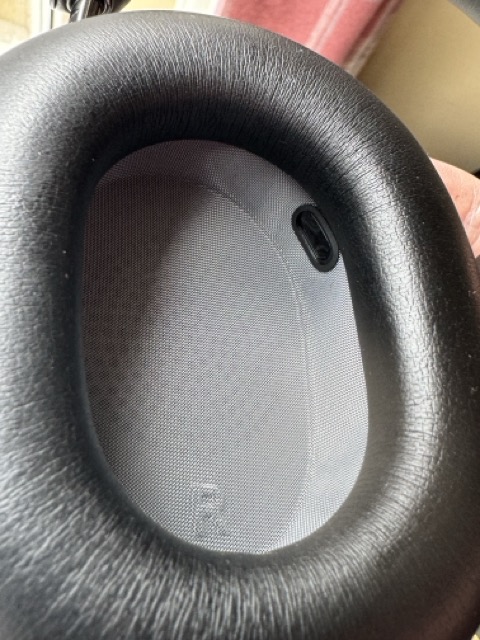
The settings can be controlled within the Sonos App:

Microphones
The Ace has a total of 8 microphones, you can see some of them on the sides and on the
bottom of each ear cup:


Buttons: Content Button Control
The Arc does not have touch controls, but you get a very clever content button, which supports sliding up and down for volume control but also pushing to select content:
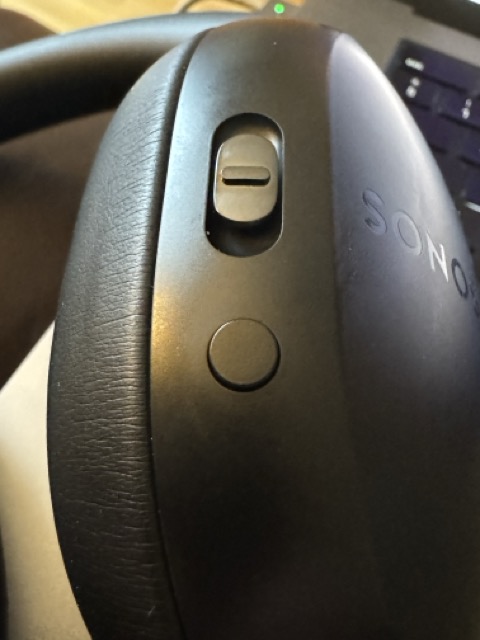
Lossless Audio Support
I briefly tried the Arc via the usb-c cable provided (strictly speaking I tried the usb-c to usb-c cable) and my Mac
showed 16bit stereo with 48Khz:

I also got ’lossless audio’ via Aptx-HD on my Android DAP though I am still slightly suspicious of that loseless bluetooth is only loseless in a ‘perfect environment’, but its good and right that a premium ANC headphone should have loseless audio in 2024. Apple will need to do something very soon with their Airpods Max connectivity to not be left behind.
Battery life
In summary, the battery life has been great, I only charged them fully once in my 2 weeks and did utilise the quick charge capability a few times, plug them in for a few minutes to rapidly ’top up’ the battery levels, its ‘3 minutes for 3 hours’. The rated battery of up to 30 hours and 24 hours with ANC enable is very believable.
ANC Performance
The active noise cancellation (ANC) on the Sonos Ace is superb, especially for indoor use.
The ANC can be toggled using

In my experience, the Ace were the best ANC headphones I have heard at mute the sounds of noisy home environment effectively, providing a quiet and focused listening experience. I swapped between the Ace and the Airpods Max numerous times for this review and this would be my comparisons:
- Indoor ANC: The Sonos Ace outperforms the AirPods Max in indoor settings, offering superior noise cancellation for typical household noises, TV’s in other rooms and noisy kids talking were almost completely muted.
- Outdoor ANC: The AirPods Max still holds a slight edge in outdoor ANC performance, particularly in handling wind noise and more complex outdoor soundscapes.
TV Audio Swap (Sonos Soundbar Swap)
I was not able to test this as it currently only supports the Sonos Arc Soundbar but for those in the Sonos
ecosystem this will be a major feature.
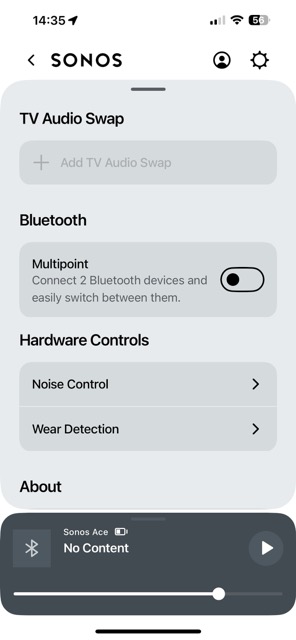
The idea is to press the button on the left earcup and the sound will automatically mute on your Television and switch the audio to your Ace headphones, that is assuming you are using a Sonos Arc or ( though not yet ) a Sonos Beam.
Note: One of the major complaints so far with the Ace has been the lack of deep integration with other Sonos products, specifically Sonos typically uses Wifi for streaming audio yet the Sonos is uses bluetooth so is excluded from mainly of the typically slick integrations that Sonos provide. The reason nobody has yet done a pure wifi headphone is really that it would be a battery life killer, so it was an obviously trade off to have up to 30 hours battery or a few hours with a heavier battery.
Internal Components
I thought some of the details which iFixit found when taking apart the Arc
are very interesting.

Specifically I think its very interesting that Sonos have used the QCC5181 chipset:

The datasheet
for the QCC1581 reveals lots of extra potential capabilties which we do not currently see being utilised by Sonos:

I specifically like that this CPU includes the “Dual 120MHz (240MHz³) Kalimba audio DSP cores” which provides 10
band PEQ filters to applications using this chipset. Sonos are obviously using 2 PEQ filters for the Bass and Treble
adjustments within the app, but that leaves lots of potential for future DSP tweaks and in my EQ recommendations
that I have later in this review, I decided to assume that ultimately someone can take advantage of a possible future
update where Sonos can ultimately add PEQ to the Sonos App for the ACE.
Sonos App:
The first time I paired the ACE with the Sonos App I was notified about a firmware update:

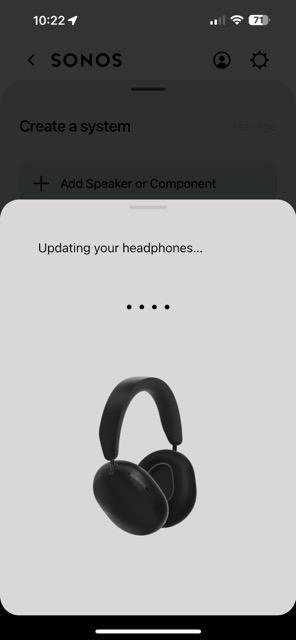
Home screen:
So far though the Sonos App has a minimal amount of features for the Ace:

Clicking on the ACE opens the configuration screens:

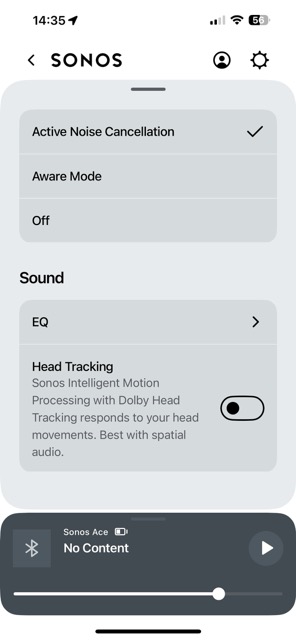
Clicking on the ‘settings’ icon in the top righthand side reveals
some more settings:

EQ Configuration
Currently, the EQ configuration within the Sonos application is very limited, with really just Bass and Treble
configration:
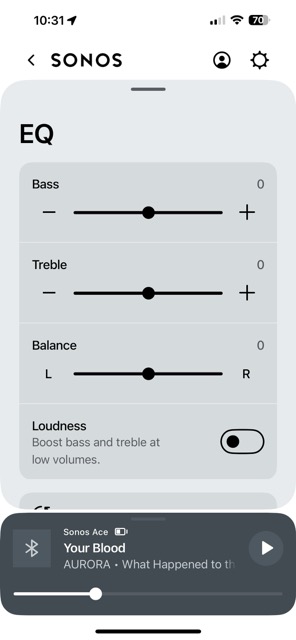
As I mentioned in the hardware section above, I believe there are lots of potential with internal hardware as far as sound configuration, so I would encourage Sonos to extend the support on this screen with both ‘preset’ profiles (I think Moondrop have done a good job recently with ‘custom’ profiles like ‘Basshead’ or ‘Reference’ where they fine tune many aspects of the frequency response to give a more familiar sound profile). Of course, a ‘custom’ PEQ with a full 10 band of filters would be amazing and would change my overall opinion about the Ace as you will see in the Sound profile section.
Sound Quality
For my sound quality, I listen to my very long ‘audiotest’ playlist listening for typical ’tells’ within familiar songs and pretty quickly i felt there was too much bass ( which of course is typical of ‘consumer audio’ ) but I lowered the bass by 3 within the EQ configuration and continued for a few days. My overall summary was some songs were excellent but then others where just wrong tonally but let me get into some examples:
Bass
The Sonos Ace has a notable issue with the mid-bass, which even after I lowered the bass can sometimes sound muddy and lack the punch that many listeners might expect. It didn’t affect some classic audiophile tracks like ‘James Blakes’ ‘Limit to your love’ which sounded pretty good, but then ‘Massive Attacks’ ‘Angel’ sounded very muddy.
Midrange
The midrange was pretty clear and well-articulated, providing a good balance for vocals and instruments. However, it doesn’t stand out as exceptionally detailed or rich, and it was only when I lowered the bass, did i feel that it wasn’t getting overloaded. In this price category and with Sonos reputation I would have expected more but overall it is not bad for an ANC headphone, the midrange was fine.
Treble
So part of my processes when I first get a new headphone is, I do listen to a Sweep to see any obviously peaks and trough and it was immediately obvious that there was a large peak (that you will see in the measurements in a little while), initially I lowered the Treble in the Sonos App but that just made the Sonos Ace sound boring, and it should not sound boring so just left the treble as default and listened. So this treble peak cause some sibilant songs to sound especially ‘sharp’ where listening too long would get uncomfortable. Put on an 1980’s electronic playlist (maybe with New Order or the Cure) and it will too much for a long session. Other examples, where The Beatles “She said, she said (2022 remix)” where it was very sibilant.
Soundstage and Imaging
The soundstage is decent for closed-back ANC headphones, offering a reasonable sense of space and instrument separation. But when I listened to some spatial Audio tracks that impression changed. I think Sonos have done an excellent job with the spatial audio. There are clever features supported by the Ace including detecting when you move and switching from spatial to stereo and then switching back when you sit down again. Both the Airpods Max and the Ace have made me feel that ultimately Spatial Audio with the right material is the future of audio.
Specifications and Measurements
- Driver Configuration: 40mm Dynamic Drivers
- Height: 7.52 in (191 mm)
- Width: 6.3 in (160 mm)
- Depth: 3.35 in (85 mm)
- Bluetooth Version: Bluetooth 5.4
- Battery Life: 1060 mAh battery provides up to 30 hours or 24 hours with ANC
Measurements
*Note: These measurements where made with my clone KB501X soft ear pinna with a 711 clone coupler using REW.
These measurements are also available on my measurements headphone database *
Lets get into them:
Frequency Response
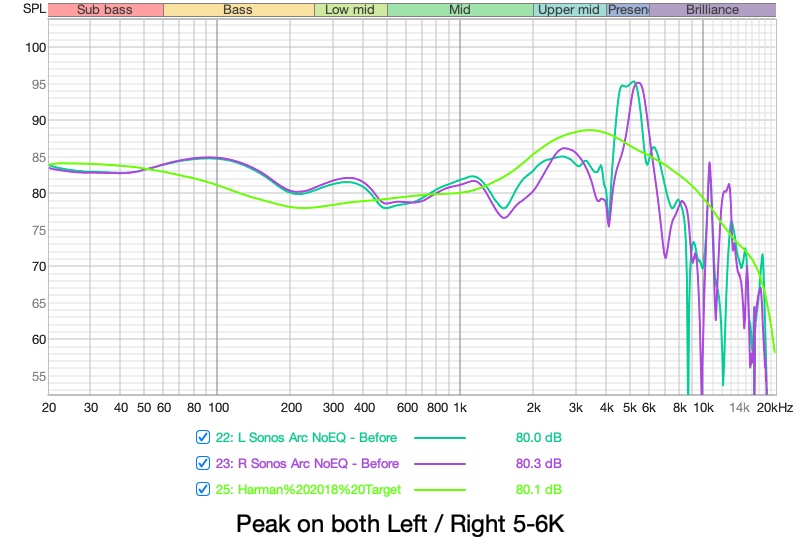
For comparison, I have added the 2018 Harman Target, but you can see the mid-bass hump and especially that treble peak which is way beyond what it should be in a headphone at this price.
The balance is reasonable good for a headphone so useful for some EQ which I will present later.
I initially thought this might just be some unit variations, where I might have received an early version of a
product, but then I spotted the Headphones.com teams measurements:

You can clearly see the same mid bass bump and that treble peak their measurements.
Sonos App ‘EQ’ ranges
Since there is Bass and Treble EQ within the Sonos App I thought I would measure the difference it makes:
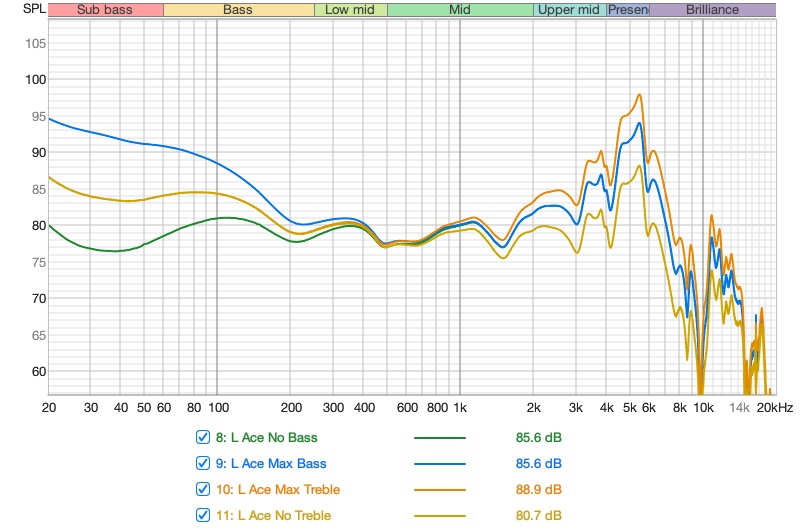
Loudness compensation
Since it is a feature of the App I thought I would measure the differences you get with Loudness compensation turned on:
 As you can see at lower volumes you get considerable more bass but about the same treble.
As you can see at lower volumes you get considerable more bass but about the same treble.
Note: I disabled it for my listening.
Distortion
So, I measured distortion at various volumes, let start with a more normal volume:
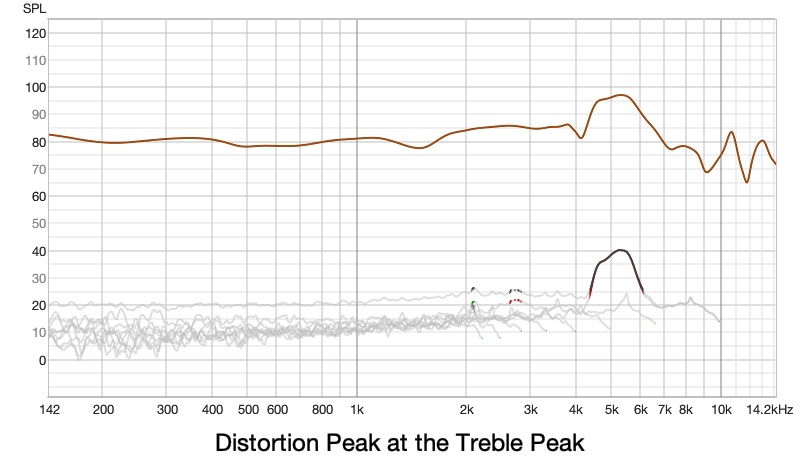
You can see a distortion peak exactly in line with that Treble peak. Of course when I ‘fix’ the treble using EQ
and remeasure I get no distortion:

But I also measured the distortion at louder volumes:

Showing the distortion as a percentage shows it is very significant at loud volumes:

Group Delay
 This does get a messy around the same frequencies that we have the distortion and high treble peaks.
This does get a messy around the same frequencies that we have the distortion and high treble peaks.
Frequency Response Comparisons
For the purposes of this review I have been comparing the Ace with my Airpods Max but also with some of my more
traditional headphones in this price range, for example the Sennheiser HD600:

So from a sound perspective, as you can see from the graph Airpods Max have a massive sub-bass boost but otherwise are fairly neutral until the treble region. The Sonos Ace on the other hand as a ‘mid-bass’ boost and an uneven midrange and its that most disturbing treble peak that I mentioned earlier. The HD600 lacks bass (without EQ) but otherwise is mostly a reference ’neutral’ headphone and why it is a good benchmark to compare other headphones, especially ones which have built in DSP capabilities as they could be tuned to match the profile of the HD600.
Some EQ Recommendations
After my first week with the ACE I decided to listen exclusively with some PEQ filters. Because of what I learned with the internals of the Ace, I felt, i should use just a few relatively simple filters which you can obviously apply on the Windows / Mac or Android App of EQ App of choice (though I do hope eventually within the Sonos App itself).

Preamp: 0 dB
Filter 1: ON PK Fc 120 Hz Gain -6 dB Q 1.41
Filter 2: ON PK Fc 360 Hz Gain -4 dB Q 2.61
Filter 3: ON PK Fc 1200 Hz Gain -3.56 dB Q 1.41
Filter 4: ON PK Fc 1500 Hz Gain 4.43 dB Q 3.19
Filter 5: ON PK Fc 3700 Hz Gain 8.42 dB Q 3.19
Filter 6: ON PK Fc 5000 Hz Gain -9.27 dB Q 2.87
I could have added more filters and smoothen out other aspects but the 711 may not be the most accurate in low frequencies or in the upper treble so I mostly focused on where I felt would be most beneficial.
Using these EQ I then compared the Ace with some other headphones in my collection you can see it is suddenly very
competitive:
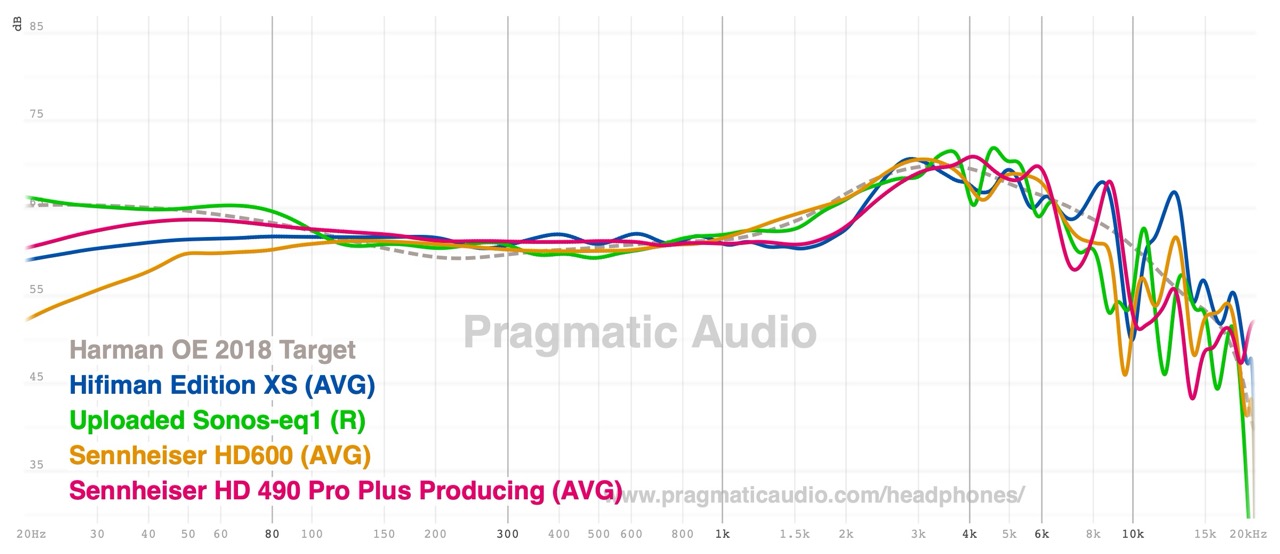
Rating
For my pragmatic rating, I like to see a balance between sound quality, features and price, but the sound quality at this price is letting down the Ace even though it has some tremendous features like the quality of the ANC and its overall build quality. So, I have given a pragmatic 3-star rating. For ANC quality, I would actually give it a 5-star and for comfort and build quality I would also give it a very high rating, if it was price at say $350 the overall rating would be 4-stars and if Sonos improve the sound profile using their DSP (or offer more control for power users to tweak the profile using PEQ filters) they this headphone would move to a 5-star rating.
Conclusion
The Sonos Ace headphones are a solid first attempt by Sonos in the headphone market. Priced at $449, they probably suffer a little in comparison to the more established brands at the premium tier, but I do think the hardware is almost perfect, as Sonos got so many things right with this headphone for a first attempt, and it’s just the sound quality that is currently letting down the Ace and this can be tweaked by Sonos given the internal hardware.
The ANC is superb top quality, especially in a home environment, the Spatial Audio is fun, the TV Audio swap will be great for those with compatibility soundbars.
With Sonos’s track record of ongoing improvements through their app, the Ace is worth considering, especially for those who prioritize noise cancellation and comfort over “perfect” sound quality as I would not be surprised if we see lots of new features being added over the next few months.